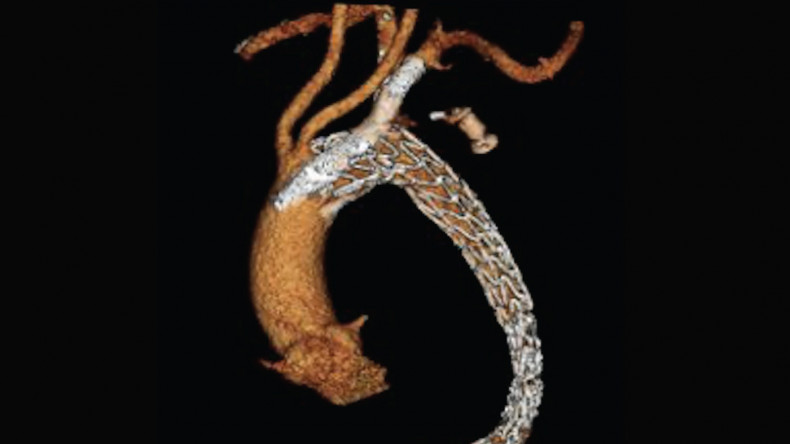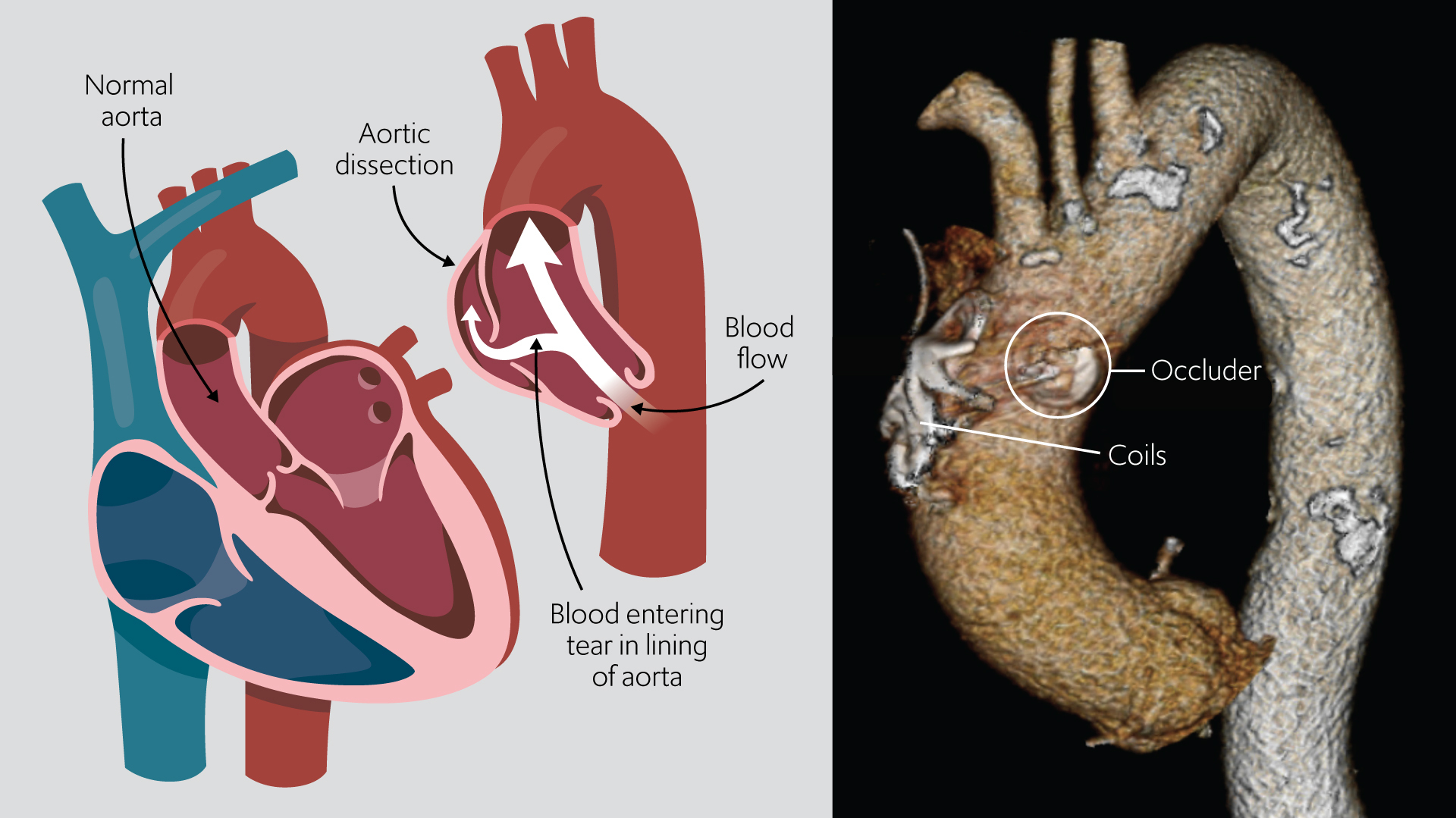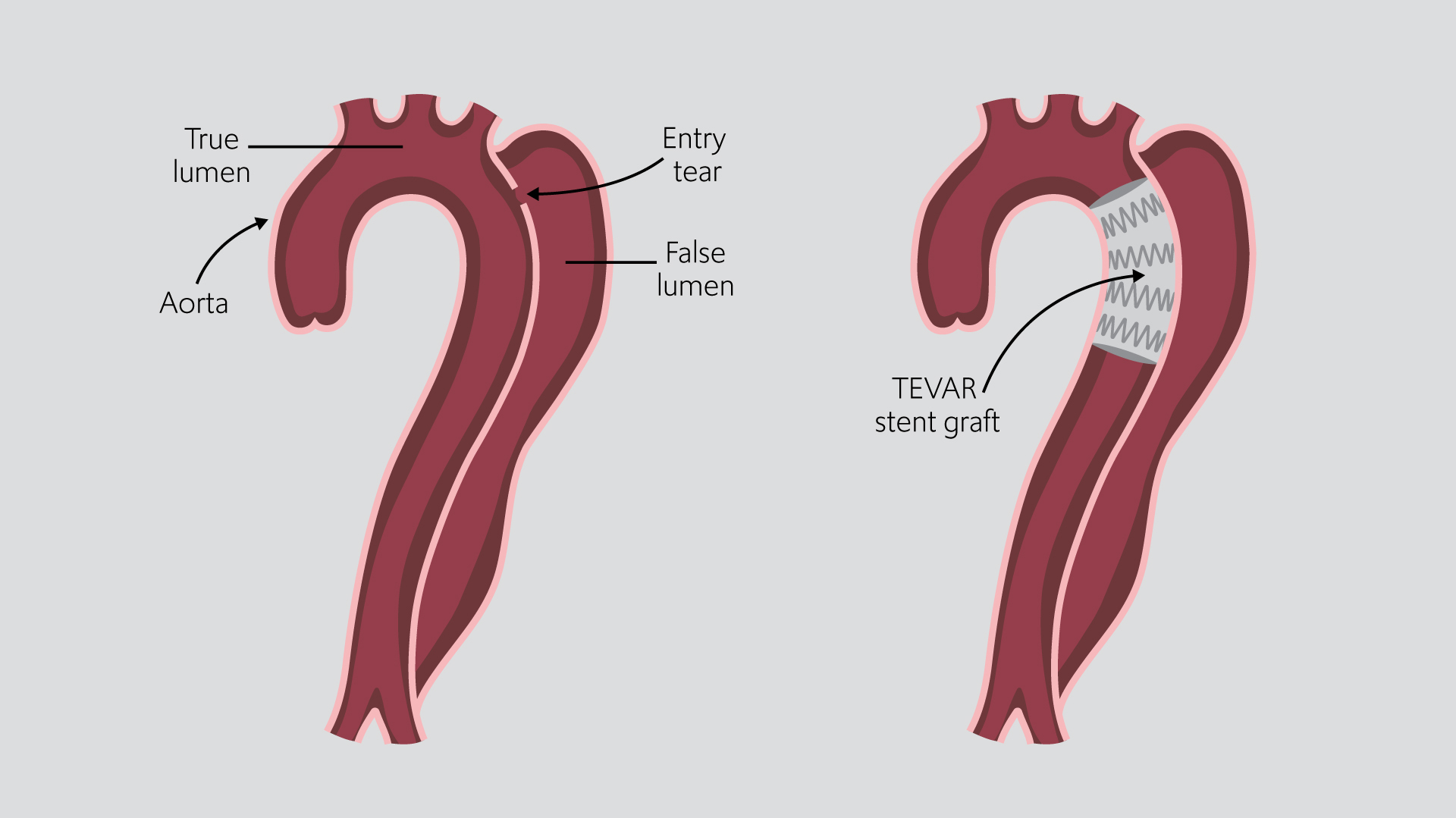Our cardiologists have developed a new ancillary (supportive) minimally invasive procedure called FLIRT, that enables us to treat problematic tears in the aorta – the body’s largest blood vessel. It offers a treatment option when there are new or residual tears in the aorta following previous interventions.

A CT scan of a successful FLIRT procedure that treats problematic tears in the aorta following previous interventions.
Aortic dissection – a tear in the body’s main artery
The aorta is the body’s largest blood vessel and carries oxygen-rich blood from the heart to all the other organs.
Aortic dissection occurs when a tear develops in the inner layer of the wall of the aorta due to weakening as we get older – it is most common in those over 60.
Blood enters through the tear causing the inner and middle layers of the aorta’s wall to split (called a ‘dissection’) and expand, termed ‘false lumen expansion’.
If left untreated, there is a chance the wall of the aorta could rupture, which can be fatal.

(Left) An aortic dissection occurs when there is a tear in the lining of the aorta and blood enters the layers of its wall. If left untreated, this can result in a rupture. (Right) A CT scan after a successful FLIRT procedure (see below) to treat the tear in the aorta.
Treating aortic dissection
TEVAR is a minimally invasive procedure recommended to treat an aortic dissection.
It stands for ‘Thoracic EndoVascular Aortic Repair’ and involves inserting a stent graft (a tube-like metal mesh covered in polyester fabric) at the point of the tear in the wall of the aorta via a small incision in the leg.
The procedure repairs the aorta from within and allows blood to be redirected down the artificial tube of the stent graft, removing pressure from the torn part of the aorta. It also seals off the false lumen which blood was flowing into.
The success rate of the TEVAR procedure to treat an aortic dissection is very high (>90%). It is also much safer than surgery which is the alternative treatment option – there is a reduced risk of fatality during a TEVAR procedure when compared with surgery.

(A) A tear in the wall of the aorta can result in blood flowing in between its layers, resulting in the development of a ‘false lumen’. (B) The TEVAR procedure is the recommended minimally invasive treatment and positions a stent graft to cover and bypass the tear, enabling blood flow to return to normal.
Sometimes, problems re-emerge
Although the TEVAR procedure is normally very successful, 2% of patients may experience a new tear in their aorta, or the stent graft may move slightly over time to re-expose the original tear.
Unfortunately, this means that blood can flow back into the false lumen and increase the risk of fatality.
To overcome this problem, our cardiology experts have developed an innovative new procedure that can seal the tear, called FLIRT (which stands for ‘False Lumen Intervention for the promotion of Remodelling and Thrombosis’).
What does FLIRT involve?
FLIRT is a minimally invasive procedure which uses advanced imaging techniques to guide a catheter and wire (a tube-like device) through a vein in your arm or groin directly to where it is needed in the aorta to deliver treatment that seals the tear.
Once successfully complete, the FLIRT procedure prevents blood flowing into the false lumen and allows it to flow correctly down the aorta once more.
As the procedure requires treatment to be delivered in between the delicate layers of the false lumen in the wall of the aorta, it needs an expert set of hands to deliver it.
“The FLIRT procedure can be complex, but we have some of the most advanced facilities at our hospitals and highly skilled cardiologists who are able to perform it,” explains our consultant cardiologist, Professor Christoph Nienaber, who pioneered the FLIRT and TEVAR procedure.
Patients often don’t experience symptoms
“Most patients won’t develop symptoms of false lumen expansion following a TEVAR procedure, so it is important that patients be continuously monitored by their consultant to detect the problem as soon as possible,” explains Professor Nienaber.
It is estimated that two thirds of patients with false lumen expansion following a TEVAR procedure show no symptoms or very mild ones including back pain and chest pain.
We have an ‘aortopathy clinic’ at our hospitals devoted to monitoring patients who have had procedures like TEVAR.
We monitor 300-400 patients each year and we have identified 16 patients so far in need of the FLIRT procedure. All procedures were successfully completed with no complications.
Get in touch
For more information or to book an appointment, please contact our customer care team.
Related content
-
Aortic aneurysm
Aortic aneurysm occurs when a part of the aorta becomes weak and becomes enlarged.
-
Aortic disease
Aortic stenosis is a narrowing of the aortic valve opening, restricting blood flow to the aorta.
-
Aortic dissection
Aortic dissection is when the aorta tears causing blood to rush through.
-
FLIRT (False Lumen Intervention to Promote Remodelling and Thrombosis)
Although the vast majority of TEVAR procedures are very successful, 2% of patients may require reintervention. For this, our cardiology experts developed FLIRT.
-
Thoracic endovascular aortic repair (TEVAR) procedure
TEVAR uses a stent-graft to reinforce and repair a weakened section of the aorta.
-
UK’s first TEVAR procedure with a unibody stent

